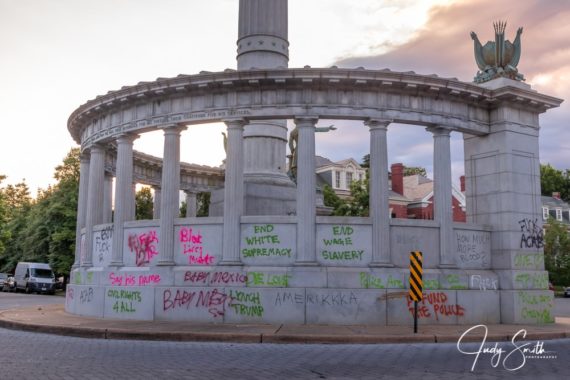For anyone with a casual knowledge about Alabama’s juicy and active history, the words “Tuskegee” and “Confederate” seem to be an odd match. Tuskegee, Alabama is the site of Booker T. Washington’s visionary Tuskegee Institute, the home of the legendary Tuskegee Airmen, and the location of the first integrated public high school in Alabama. And yet, the center of town is dominated by a city block-sized park under the watchful and protective gaze of a brave and honorable Confederate soldier. At the very least, he is a soldier who should be commended for his survival of the carnage of late concerning Confederate Memorials throughout the South. And although (as of this writing) the Alabama House recently passed legislation requiring local governments to get the state’s permission before removing any historical monuments (Alabama Heritage Preservation Act), this lone and dedicated soldier has managed to hold off many vicious attacks over the last 60 years about his presence. He doesn’t need the legislature’s help. He’s not going anywhere.
Today, Tuskegee is now an unrecognizable shell of its former self, but it used to be one of the greatest small towns in America. I’ve written a couple of blogs for Abbeville about the turmoil surrounding the integration of Tuskegee High School in 1963, and Tuskegee became one of the state’s natural focal points for civil rights demonstrations. In fact, the history of Tuskegee’s political activism goes a lot farther back than Selma and Birmingham. In the late 1950’s, the city of Tuskegee committed obvious gerrymandering in redrawing the city limits to exclude newly registered black voters. The famous Montgomery Bus Boycott had only ended a year earlier, and disenfranchised black citizens of Tuskegee organized a crippling three-year boycott of white-owned businesses of downtown Tuskegee. The volatile situation eventually ended with a lawsuit that reached the US Supreme Court in 1960 (Gomillion vs Lightfoot).
The downtown area of Tuskegee is much like so many other small Southern towns. The main highway doesn’t go through downtown, but around the center of it like a giant English roundabout. Or maybe a “square-about.” The obligatory courthouse stands on one end of the town square, and the Confederate Memorial statue stands at the other. The quiet and graceful park that stands between them has always been a natural gathering point for the citizens of Tuskegee. Over the past 60 years, there were numerous civil rights-themed protests in the town square of Tuskegee, all under the watchful gaze of the Confederate soldier. The black boycott of the late 50’s. The high school integration of the early 60’s. And the explosive congregations surrounding the killing of a political activist in a Tuskegee gas station in 1966. During those ominous weeks of marches and protests, Tuskegee’s Confederate soldier received many coats of unauthorized paint, as well as quite a bit of unseemly graffiti. Yet, every time the soldier was painted, he was miraculously cleaned up. Today, he remains clean and proud, surrounded by a healthy crop of azaleas.
In the summer of 2015, when many lunatics were obsessed with the ethnic cleansing of Confederate Memorials across the South, the lonely old statue in Tuskegee remained steadfast. He didn’t hide. He didn’t flinch. He stood upright and tall in the very heart of downtown Tuskegee. And as I said, he’s not going anywhere.
You see, the town square in Tuskegee is actually private property. The whole park, including that magnificent Confederate soldier, is owned by the United Daughters of the Confederacy. They bought that land from the City of Tuskegee and erected the statue in 1906. The inscription on the memorial reads as follows:
“1861-1865”
“Erected by the Daughters of the Confederacy to the Confederate Soldiers of Macon County.”
“Honor the Brave”
No truer words have been spoken.






